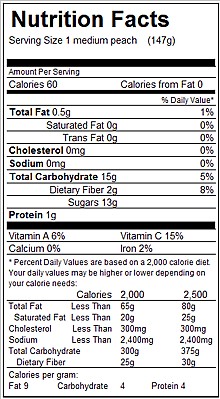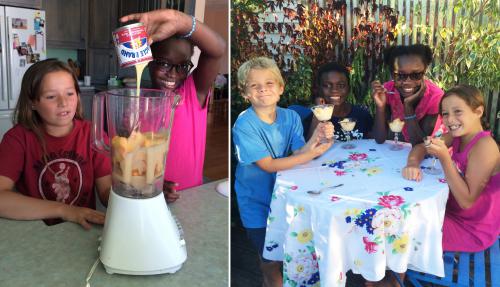Plant science at the dinner table: peaches
Peaches can be eaten fresh or used for making peach cobbler, jam pie or peach ice cream.

Enjoy fresh peaches, peach cobbler, jam pie or peach ice cream and learn more about this tasty fruit. Learning more about the foods we eat, how they grow, where they come from and teaching children a little plant science is a great activity for young and old.
Fun facts about peaches
- Peach fruit is botanically known as drupe (stone fruit). It consists of white or yellow flesh that is covered with yellowish-red, velvety skin.
- The flowers have male (stamens) and female (pistil) reproductive organs.
- Honey bees are the main pollinators of peach flowers.
- Peach seeds are large, oval-shaped and protected with a woody husk. The seeds contain hydrocyanic acid, which is poisonous.
- Nectarines are a type of peach that have smooth skin instead of velvety, which is typical for peaches.
- Peaches are rich source of vitamin C, A and E.

- They also contain high amounts of potassium, magnesium, zinc and phosphorus.
- Peaches are members of the Rosaceae family and are a close relative of almonds.
- China is the biggest producer of peaches. Italy is second.
- Peaches are believed to have a diuretic effect; you can eat these fruits to cleanse your kidneys and bladder.
- Peaches are used in cosmetics as a moisturizer.
- They may reduce hair loss if eaten and applied to the skin and scalp.
- Peaches originated from China and were introduced to the West through Persia.
- In China, peaches are a symbol of good luck, protection and longevity.
- The ancient Romans thought peaches originated from Persia (modern day Iran) – its scientific name also reflects this: Prunus persica. Peaches were often called “Persian apples.”
- The peach tree is often considered to be the tree of life.
- Christopher Columbus brought several peach trees to America on his second and third voyages.
- Georgia is known as the Peach State, although California produces about 50 percent of all peaches in the U.S.
Peach sherbet recipe
Looking for a fun way to enjoy peaches? Here is a quick and simple recipe for peach sherbet that is smooth, sweet and creamy – and made with only two ingredients! This is so simple that kids can make it by themselves.
Time
4.5 hours (includes 4 hours to freeze peach slices)
Servings
8 servings
Ingredients
- 1 can sweetened condensed milk
- 5 large (or 6 medium) ripe peaches, peeled, sliced and frozen
Instructions
- Peel fresh peaches over a wax paper-lined baking sheet to catch the juice. Slice the peaches and lay them in a single layer on the wax paper-lined baking sheet. Place slices (and any accumulated juice) in freezer until frozen, about 4 hours.
- Add the peaches and sweetened condensed milk to a blender and puree until the peaches are the consistency of soft serve ice cream. This can be done in batches if needed.
- Serve immediately or freeze in an airtight container for an ice cream consistency.
More information
To learn more about growing peaches in Michigan, see the Michigan State University Extension resources, "Planting fruit trees" by Ron Perry.



 Print
Print Email
Email










